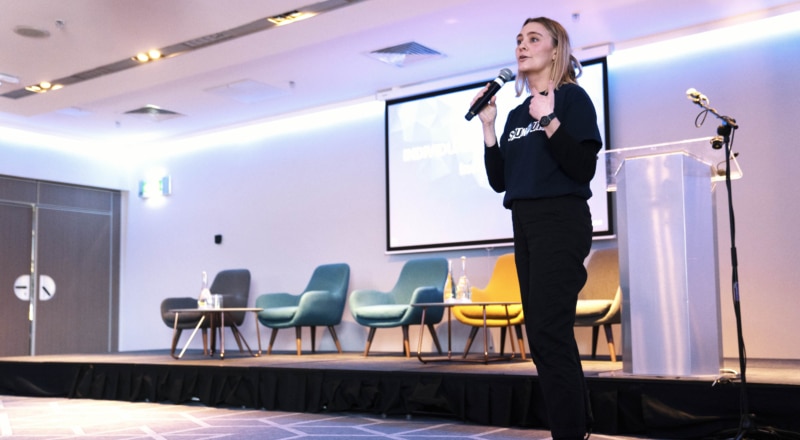What happens at a SpunOut.ie Consent Workshop?
Learn more about the consent workshops we provide and how to organise one

Consent workshops are aimed to provide people with sexual health information, and an opportunity to understand and practice consent in a positive space.
What is consent?
Consent is permission for someone to do something, or an agreement between people to do something. Sexual consent is a topic which has been increasingly discussed at third level education for the past few years, with events like SHAG, SHIFT and KISS weeks taking place in colleges across the country during freshers week.
In all circumstances where we are intimate with someone, consent needs to be established first, so that we can be sure everyone feels comfortable and respected. When having sex, consent is an agreement between all participants that they definitely want to have sex, or do any sexual act. Everyone needs to fully, clearly, and enthusiastically agree to it, and their consent must be continuous for the duration of sex. This means that they have the right to change their mind at any time, for any reason, without any consequences.
Consent is needed for vaginal, anal or oral sex, mutual masturbation, sexual touching or kissing. Consent is also needing for sexting, sending sexual material online, or making sexual comments or propositions.
Consent can be expressed both verbally and physically – so it can be with words, as well as actions and body language. It must be conscious and voluntary. Consent should be given freely without any manipulation, convincing, or threats. From a legal perspective, sexual consent is mandatory. If consent is not expressed, this is not sex – it is assault.
How can consent be explain at in a workshop?
Smart Consent is a sexual consent workshop which aims to educate students at third level on what consent is and to push the message that ‘no means no’. Smart Consent explores all different dimensions of consent, which relate to:
- S – all sexual orientations and genders
- M – state of mind, i.e. willingness, no pressure, not under the influence of drugs or alcohol
- A – activities on an on going basis, i.e. kissing, touching, oral, etc.
- R – all relationships, both casual and committed
- T – talking, and non-verbal signs and signals
Planned Parenthood in the United States has had success with their acronym to remember consent called ‘FRIES.’ Fries stands for:
- F – Freely Given
- R – Reversible
- I – Informed
- E – Enthusiastic
- S – Specific
Another description of consent that went viral was a YouTube video which the likened consent to how people like their cups of tea.
What can you expect at SpunOut.ie consent workshops?
In our consent workshop our facilitator will explain the concept of sexual consent clearly, as well as explain why understanding consent is necessary for overall sexual and relationship health. This can include everything about sex, such as different forms of contraception, STIs and consensual sex. You might be asked about your understanding of the different terms and knowledge on different forms of each.
Are consent workshops different from organisation to organisation?
Every consent workshop follows their own guide on how they are delivered, so it is very rare to find two which will be the same, and much can be learned from all of them. Workshops also usually involve an element of experiential learning, or learning through experience, activities and reflection, to show examples of how consent works.
Different consent scenarios
There are many different types of activities you might experience in a consent workshop. A common one is going through ‘consent scenarios.’ This might include acting out scenarios in a group, or perhaps just reading and discussing different scenes.
Scenarios are useful because it helps you learn to identify when consent is clearly and enthusiastically present, and when it’s not. You can also prepare your responses to potential real-life situations ahead of time.
In some of the SpunOut.ie consent workshops, participants play a game where each person receives a scenario or action on a piece of paper that they have to place on a spectrum of behaviours. One side of the room is marked ‘Consensual’ while the other is ‘Non Consensual.’ Everyone must place their card somewhere between these two points, in relation to everyone else’s cards. This activity typically brings up people’s understanding of consent, their feelings around it, and what situations they judge to be particularly extreme. It also can help identify the nuances of consent that someone might not have considered before.
An example of this is the card: ‘You give your date a kiss at the end of the evening after dinner went well.’ Someone with this card might place it towards the ‘Consensual’ side of the room based off of a judgement that the kiss in this situation is wanted. Or, the card could be placed at the middle or towards the ‘Non Consensual’ side because we do not know if the other person consents to the kiss just because dinner seemed to ‘go well.’ The card does not give details on verbal consent or clues about the date’s body language. This sort of ambiguity can prompt discussion amongst the group as to how consensual the situation really is.
Practicing Consent
Another activity you might find in our consent workshop are exercises that help you actively practice consent. You can practice consent by learning how to make a boundary with another person, and by practicing noticing and respecting when someone makes a boundary with you. A big part of respecting people’s personal boundaries is recognising body language.
A ‘boundary’ is a limit within a relationship, and all relationships have them even if we do not realise it. You probably wouldn’t go up and hug a stranger on a bus, because you do not know them and there is an unspoken social boundary of personal space. A friend you have only recently met, you might not hug right away, whereas a friend you have had for a long time you might hug as soon as you see them. Boundaries are different with everyone, and while some are discussed openly, others are unspoken.
In one type of ‘Practicing Boundaries’ exercise, people are asked to get into pairs and make an unspoken boundary with their partner. Each participant has to be able to communicate their physical boundary to their partner silently and also be watching for their partner’s boundary. This exercise can be difficult because it reveals how uncomfortable we can be telling someone ‘no’ and how important it is to notice and respect nonverbal cues.
*Accessibility Note: This exercise is not used for those with visual impairments. In the case that a group or participant/s have visual impairments we rely on verbal communication of boundaries and consent rather than visually reading body language.
What is the cost of a consent workshop?
Most consent workshops are free to take part in. Many are run in schools and colleges throughout the country by bringing in an outside facilitator.
If you are interested in booking a consent workshop, or other topics, please click here to submit a request.






